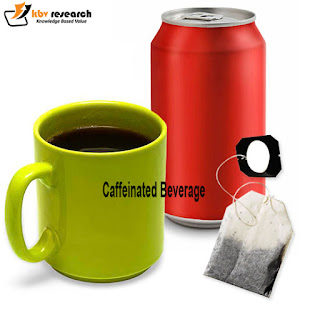Why have caffeinated beverages become a major industry?
A caffeinated beverage is a drink
containing caffeine, a stimulant that is legal and common in most developed
countries. Coffee and tea, that in one form or another (usually served hot but
sometimes iced) appear in most world cultures, are the most popular naturally
caffeinated beverages. As a part of their production process, many beverages
are heavily caffeinated. These include some soft drinks (mainly cola drinks),
as well as energy drinks intended as a stimulant, and perpetuating activity at
times when the user may normally be asleep.
The use of caffeinated drinks is
often meant for the physical and mental effects of caffeine in whole or in
part. For example, the consumption of tea or coffee with breakfast in many
Westernized cultures to 'wake up' or the intentional intake of energy drinks by
night-time students, or revelers trying to maintain a vigilant behavior during
social recreation. If ingested in excessive amounts, however, caffeine can
cause physical dependence. When individuals feel headaches, exhaustion, and
muscle pain 24 hours after their last energy drink, the need for caffeine can
be detected.
Many widely sold drinks contain
guarana, a South American berry that contains about twice caffeine as much as
coffee beans. Most caffeinated beverages also have decaffeinated equivalents
for those who like the taste but want to limit their intake of caffeine due to
their physical effects or due to the drug's religious or health beliefs and
their results. Several alcoholic beverage companies have started manufacturing
caffeinated alcoholic beverages in recent years. Much controversy has been met
with the production of such beverages.
Energizing Effects of Caffeine
Caffeine is usually used to
increase concentration and alertness because of its effects on the central
nervous system, according to research published in Advances in Nutrition in
January 2015. In medications, caffeine can also be used to treat headaches,
asthma, and pain relief. This study focused on the use of caffeine in children
and adolescents from food and beverages. The study concluded that a growing
trend among adolescents and youth in caffeine-containing energy drinks (CCEDs)
along with soda, coffee and tea led to an increase in the total consumption of
caffeine.
Caffeine Considerations
Although moderate caffeine is
generally safe for most healthy adults, it can have adverse side effects to
drink too much caffeine. Since caffeinated drinks such as colas, coffees, and
teas draw water out of the body as a diuretic, such drinks contain unnecessary
caffeine that may contribute to dehydration.
For some populations potentially
vulnerable to the negative effects of caffeine consumption, caffeine
consumption could be dangerous, including pregnant and lactating women,
infants, teenagers, young adults, and those with underlying heart conditions or
other health conditions, such as mental illness. Excess caffeine can contribute
to cardiovascular dysfunction, sleep, blood pressure changes and/or numbness.
· Unique advertising campaigns by the key players
Innovative marketing and branding
campaigns by energy drink manufacturers are appealing to various age groups.
Millennials are the major consumers of RTD tea and coffee. To enhance the sales
of RTD tea and coffee, market players are working on affiliation strategies
with various RTD tea and coffee manufacturers to launch new products. The new
products offered are not only ready to drink but also carry the basic
underlying taste of tea and coffee. Tata Global Beverages (TGBL) launched a
marketing campaign to launch its Tata Coffee Grand, a new instant coffee. The
launch of ‘Grand’ is in a competitive environment.
· Increased consumption of packaged soft drinks
Traditional and home-made drinks
have been popular for a long while. However, from the past two years, the
demand for non-carbonated packaged beverages is gaining immense popularity,
with a year-on-year increase. Consequently, various factors, such as increased
disposable incomes and health awareness, lead to increased demand for
non-carbonated drinks. This growth encourages industry players to focus more on
health and energy drinks, driving the market for energy drinks. Consumers have
increasingly opted in recent years for naturally safe, packaged foods and
beverages associated with organic, fortified/functional, or better-for-you
products, as they are perceived to provide the essential natural nourishment.
· Rising awareness about the health benefits of caffeine drinks
Consumption of caffeine is
associated with a number of health benefits. This protects the liver because
coffee can reduce the risk of liver damage (cirrhosis) by up to 84%. It can
delay the disease progression, improve the response to treatment, and reduce
the risk of premature death. Consumption of caffeine also encourages longevity.
Drinking coffee can reduce the risk of premature death by as much as 30% for
women and diabetics in particular. Around 2-4 cups of coffee per day can reduce
the risk of liver cancer by up to 64% and the risk of colorectal cancer by up
to 38%. Drinking 4 or more cups of coffee per day can reduce the risk of skin
cancer by 20%.
To conclude
In recent years, energy drinks
have grown into a billion-dollar industry, as customers from all walks of life
are searching for ways to boost their mental performance. Unfortunately, there
is not a very good reputation for this industry.
With a lack of knowledge and
awareness among participants, the prevalence of caffeinated beverage and energy
drink consumption is high. Caffeine is the psychoactive substance that is most
commonly used and easily available across all countries. Increased use of
caffeinated beverages and their products over the past decade has raised health
concerns worldwide, especially among young and adolescent populations. With the
introduction of red bull energy drink in 1997, the trend of energy drink became
popular.




Comments
Post a Comment